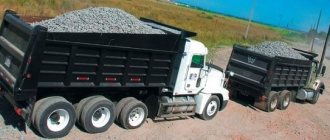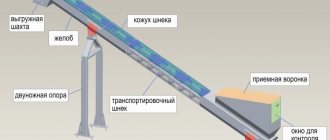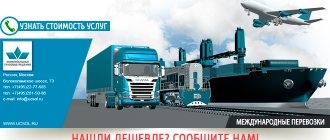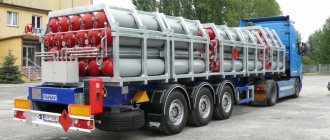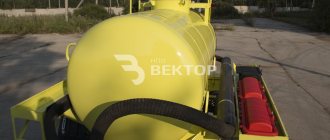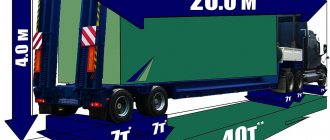Bulk materials widely used are divided into lump, dust and granular.
Dump trucks are designed for transportation of bulk cargo
Such cargo is transported mainly by enterprises of the mining, metallurgical, construction and agricultural industries. The first three actively use dump trucks for this, as well as special sealed vehicles (cement trucks). In agriculture, sealed (flour) trucks predominate; The dusty and granular materials used in this industry (fertilizers and other chemicals) are supplied in sealed packaging (bags, barrels, drums) and transported by any means of transport.
The use of dump trucks for bulk transportation of such cargo is profitable and convenient, especially unloading from the body. However, their use has mandatory rules and restrictions aimed at preventing damage to humans and nature and preserving the road surface.
These rules are different when transporting bulk cargo on public roads of all levels and on roads in the territories of industrial enterprises.
Basics
In practice, different types of transport can be used to move bulk cargo. Let's take a closer look at road and rail transportation. Marine - used only at long distances and special rules apply there. Aviation ones are expensive, so they are used relatively rarely.
High-quality transportation of bulk cargo should include:
- creating favorable conditions for quick loading/unloading;
- providing conditions to prevent losses during the movement process;
- prevention of environmental pollution;
- compliance with traffic rules when driving inside industrial facilities and on public roads;
- preparation of the necessary acceptance, accompanying and reporting documentation.
A qualified carrier optimizes all important stages of work processes, which allows him to provide services at affordable prices.
In any case, the special characteristics of the individual loads must be taken into account:
- The grain is protected from adverse external influences that cause spoilage.
- They prevent moisture from building materials so as not to complicate subsequent technological operations.
- Poisonous, toxic, and other hazardous substances are transported with special precautions.
For this purpose, suitable vehicles are selected accordingly.
Dump trucks are used to work in quarries. To transport food products, the body is covered with an awning. Chemical compounds in granules are placed in sealed containers. In some cases, in order to travel on the roads, it is necessary to obtain a permit and be accompanied by a traffic police patrol car.
Oversized cargo - general information
The oversized category includes cargo of any non-standard shape if its dimensions exceed those allowed by technical standards. It is impossible to transport such objects in a regular container, or by traditional freight transport.
In addition, the group of oversized items includes items whose dimensions are larger than the dimensions of the vehicle. In such a situation, transportation is dangerous as the likelihood of an accident increases. Such objects are classified into a separate category, for which specific transportation requirements have been developed.
The main condition for safe transportation is that the process should be organized so that all traffic participants promptly notice the transport and the cargo on it, and accordingly take the necessary precautions
Large objects are usually divided into several categories:
- large - the cargo exceeds the size of the selected transport, this creates the likelihood of congestion and road blocking;
- heavy - the cargo is too heavy, its weight exceeds the limit established for a particular type of transport.
Large products - permissible dimensions:
- width - exceeds 2.55 m;
- length - exceeds 16 m;
- height - exceeds 4 m.
Any cargo whose dimensions and weight do not correspond to the established limits is called oversized. Transportation of such objects is more expensive compared to transportation of other products.
As a rule, the list of oversized cargo includes: water transport, large agricultural machinery, any non-standard-shaped structures, machine tools, equipment for industrial facilities. Reinforced concrete and concrete products, as well as any cargo that cannot be transported closed.
To transport oversized cargo of non-standard shape, you will need a low-loader platform - after installation on it, the load becomes lower. If the load is too heavy, it is placed on an additionally reinforced platform of the required carrying capacity with an increased number of axles.
Transportation by rail
To perform such work, you should be guided by several regulatory documents:
- Orders of the Ministry of Transport of the Russian Federation No. 294 and 281 dated September 19, 2013 and September 26, 2016, respectively;
- The industry charter, which is formalized as a federal law (Federal Law No. 18).
In particular, Order 294 contains a complete list of cargoes that are classified as “bulk” and “bulk”. It contains several hundred positions, so for a detailed study it is better to use the original source.
Below are important details that will help organize delivery by rail in compliance with the rules for the transportation of bulk cargo:
- It is permissible to use open rolling stock if protection from adverse weather conditions is not required.
- Responsible employees must check the technical condition of the car before loading. They control sealing elements and blocking of locking devices.
- The serviceability of the components noted above must be ensured during transportation. It is necessary to remember about increased shock loads during sorting operations.
- Certain types of agricultural crops are allowed to be transported only in closed containers/wagons.
The last position should be studied in more detail, taking into account the characteristics of other cargoes. Sand, for example, is poured at the level of the sides or below, covered with an awning to prevent blowing out at high speed. Plaster must be protected from moisture so as not to spoil the material. Crushed stone for strengthening railway embankments is transported without special precautions. It will not be damaged by atmospheric, mechanical and other external influences.
Who can carry it out?
Transportation of waste is carried out on the basis of an agreement concluded between the business entity producing the waste and the enterprise or individual entrepreneur providing such a service. This type of activity is regulated by the state through licensing.
An organization or individual entrepreneur engaged in transportation must have a license.
The presence of such a document confirms that its owner:
- works officially;
- complies with the rules established for this type of activity;
- has special equipment and transport.
Employees of enterprises who are allowed to work, and the entrepreneur personally, undergo vocational training or receive additional vocational education. Such studies are conducted by accredited educational organizations.
Transportation by road
The basic rules were created during the Soviet Union.
They were approved by the Ministry of Road Transport of the RSFSR on July 30, 1971. In May 2007, additions were made to bring the standards into line with current conditions. You should also be guided by the provisions of the Government Decree of the Russian Federation of April 15, 2011 No. 272. As in the previous section, it is necessary to note several important nuances:
- Bulk cargo is placed no higher than the sides to prevent road surface contamination and loss.
- The carrier is responsible for safety, therefore, if necessary, he is obliged to use a protective awning.
- During the loading process, the bucket must not be moved along a path above the vehicle cabin. The driver must leave the cab when performing such operations.
- The vehicle delivery mechanism is described in detail in the contract between the customer/contractor.
- The sender ensures safety during the loading process. He installs and monitors the serviceability of barriers, sliding devices, and individual parameters of environmental pollution.
- Cleaning the body after unloading is the responsibility of the recipient. Exceptions are indicated separately in the contract.
- Quantitative verification is carried out using weighing at the sending/receiving points. For some categories of cargo (construction and household waste, snow, industrial waste) such procedures are optional.
- In a container, bulk materials are placed in a special container.
Cargo spillage is not only a direct loss due to increased losses. Such situations are accompanied by damage to one’s own and other vehicles and accidents. Unforeseen expenses can be eliminated if road transport of bulk cargo is carried out correctly.
The difference between bulky cargo
There are several concepts that define large and heavy loads. It is easy for an ignorant person to get confused in them. So, a more general concept is “oversized cargo”. It is also sometimes called non-standard.
In more simple and understandable terms, oversized cargo is a heavy or bulky item (sometimes both) that cannot be transported in the usual way in a container or closed vehicle. An example of such cargo can be agricultural machinery, drilling equipment, transformers, and so on.
Due to the wide variety of types of oversized cargo, the need for classification arose. They are divided into the following types:
- Heavy, which, after loading onto a vehicle, causes the permissible parameters for weight or axle load to be exceeded.
- Large cargo that causes the overall dimensions of vehicles to be exceeded.
- Long, which, after loading onto a vehicle train, protrudes beyond its tailgate by more than 2 meters.
Large and heavy cargo is difficult and very expensive to transport by air and rail. Therefore, road transport is most often used.
Calculation of the number of vehicles and other preparatory measures
The optimal technology is selected taking into account the volume and parameters of the cargo, distance and other features of the route. Vehicles are universal and suitable for work in quarries and construction sites. It is used for transportation between workshops of industrial enterprises and on international flights.
In a large assortment of models, it is easy to choose an option with a suitable load capacity and body dimensions. The calculation is carried out based on the required delivery schedule. The most difficult thing is to deliver cargo to several recipients with partial unloading.
It is worth checking the requirements of local authorities regarding the transportation route. Often the contractor is faced with additional restrictions (unexpected, as a rule) when working in a region other than his own. In the worst case scenario, you can get a ban on the use of a certain vehicle on a given route, for example, due to exceeding the maximum weight.
The railway is more convenient and profitable over long distances. It performs its functions uninterruptedly in difficult weather conditions. Compliance with a standard schedule allows you to accurately plan economic and commercial activities.
At the next stage, the order executor is determined. It is convenient if the carrier has a large fleet with a variety of equipment. In this case, it is easier to choose a car that exactly matches a specific task. It is acceptable to conclude one-time contracts. However, long-term cooperation is more profitable. Such relations imply not only a democratic pricing policy. Contractors may offer deferred payments and other financial and organizational benefits.
Standard rules for transporting bulk cargo by dump trucks imply the responsibility of the sender to create favorable conditions at the place where the body is filled. It is necessary to establish driveway markings, designate a potentially dangerous area, and prevent access by unauthorized persons.
Loading operations are carried out in accordance with current standards with a stable installation of the excavator and other equipment on the site. Be sure to control the maximum wind loads. Operations are not performed under conditions that could damage the cargo.
Why is waste transportation needed?
The movement of waste between treatment stages is called transportation. It begins when the exported substances leave the boundaries of the territory belonging to the owner of the waste.
Transportation becomes necessary when:
- the garbage collection schedule is observed;
- the 11-month waste accumulation period ends;
- established accumulation standards are exceeded;
- temporary storage exceeds the maximum permissible limit for hazardous substances at the storage site;
- according to technology, product residues serve as raw materials or parts thereof for other production;
- waste must be delivered to recycling collection points.
Transportation is a necessary action to ensure further work with waste. The economic component of the “garbage” business, as well as the environmental situation in the areas where waste is stored along the route of waste disposal sites, depend on the stability and correctness of its implementation.
Safe and careful delivery
The current rules for transporting bulk cargo by dump trucks imply the performance of work without special containers. It is necessary to maintain good condition of the joints between the structural parts of the body and ensure the tightness of the seals. The smallest particles can penetrate out even through thin cracks. The carrier is responsible for safety during transportation, so the relevant control measures must be carried out without errors. To avoid damage, do not exceed the standard load capacity specified in the technical data sheet.
Transportation of bulk cargo by road transport is carried out under a contract, one-time application applications. The waybill (Bill of Lading) is drawn up in accordance with current standards. It indicates the identification data of the invoice and certificates. Special marks confirm receipt of cargo in a certain quantity.
Properly drawn up accompanying documents are needed to successfully pass inspections by traffic police and accounting officers. With their help, they clarify the correctness of the actions of drivers and other workers, and pay wages to personnel. They are needed to organize accurate settlements between counterparties.
Valuable cargo is delivered under seal. Special means are used to block the locking devices connecting the flexible cable. They fix the awning on the body. It is more convenient to work with containers. They are better protected from illegal actions of attackers. To increase the level of safety, electronics are used:
- GPS trackers that quickly determine the location of vehicles;
- autonomous alarms;
- sirens with a built-in GSM unit for data transmission and remote checks.
Permission to transport bulk cargo is obtained if it is potentially dangerous to the environment and people. The vehicle is marked with special inscriptions and signs to warn other road users. In them, special signs indicate the means that need to be used during the liquidation of accidents. The list of special events was approved by Order No. 73 of the Ministry of Transport of the Russian Federation dated 08.08.1995
Oversized cargo is
Oversized cargo, also known as large cargo, also known as heavy cargo, is one whose weight and overall dimensions exceed the permissible standards established by the ministry of a particular country.
The Russian Federation Traffic Regulations establish the following parameters for oversized cargo:
- If the luggage exceeds the dimensions of the car by more than 1000 cm.
- If on the sides the load protrudes more than 40 cm from the side lights of the car.
Traffic regulations on the transportation of goods
Clause 23.5 of the traffic rules informs that a vehicle transporting oversized cargo must be marked with the sign “Large cargo”. In addition, in the evening, that is, from the beginning of evening twilight to the beginning of morning twilight, and in the daytime in conditions of poor visibility, a reflective element or white light must be installed in front of the vehicle, and a reflective element or red light must be installed in the rear . These rules are sufficient for driving on public roads.
https://youtube.com/watch?v=DsTYXUxKpLQ
Special requirements for cargo transportation
State authorities have established special standards for the transportation of explosive, chemical, flammable and other dangerous goods, long, oversized, heavy cargo.
Special rules that must be followed when driving a vehicle with or without cargo:
- If the height of the Vehicle is more than 4 meters from the road surface.
- If the vehicle width is more than 2.55 meters. For refrigerated trailers (freezers) and isothermal bodies, the permissible width is no more than 2.6 meters.
- If the length of a road train with one trailer is more than 20 meters.
- If the length of a road train with two or more trailers is more than 24 meters.
- If the overall dimensions of the transported cargo exceed the dimensions of the vehicle by 2 meters (in height and width).
- If the height of the Vehicle is more than 4 meters from the road surface.
- If the vehicle width is more than 2.55 meters. For refrigerated trailers (freezers) and isothermal bodies, the permissible width is no more than 2.6 meters.
- If the length of a road train with one trailer is more than 20 meters.
- If the length of a road train with two or more trailers is more than 24 meters.
- If the overall dimensions of the transported cargo exceed the dimensions of the vehicle by 2 meters (in height and width). Additionally, if the cargo is oversized, you need permission from the traffic police. The main value is the weight of the vehicle along with the cargo being transported.
If the route for transporting oversized cargo takes into account crossing the border of States, then it is necessary to comply with the requirements of the laws of the country in which the cargo is transported.
- Two-axle vehicles with a load, if their weight is more than 18 tons.
- Three-axle vehicles with cargo, if their weight is more than 25 tons.
- Four-axle vehicles with cargo, if their weight is more than 32 tons.
- Three-axle road train with cargo, if their weight is more than 28 tons.
- Four-axle road train with cargo, if their weight is more than 36 tons.
- Five-axle road train with cargo, if their weight is more than 40 tons.
- A six-axle road train with cargo, if its weight is more than 44 tons.
No less stringent standards are the distribution of weight along the axles. Both the distance between the axles and the road load standards are important. Standards for permissible loads on roads are established during the design and construction of roads, for example, there is a permissible load on one axle of 10 tons, 6 tons, 11 tons, 5 tons, etc. Based on the mass on the axle, a route is laid out. Therefore, truck drivers have to drive not along the short route, but along the permitted route.
“Oversized cargo” sign “Long road train” sign “Long vehicle” sign If a vehicle transports cargo that is classified as dangerous, then the following sign must be installed on it: Which goods are considered dangerous. See classification:
Cross-border transportation
Waste can move not only across the country, but also across the territories of two or more states.
This is the so-called cross-border transport, which can be from the waste sending country to :
- another state receiving this garbage;
- another country through the territory of a third or several neighboring countries;
- an area not under anyone's jurisdiction.
It is prohibited to import waste into the territory of Russia for its neutralization and burial. It is allowed to import waste for recycling purposes under a license from the Ministry of Industry and Trade of the Russian Federation and permission from Rosprirodnadzor.
The procedure for cross-border transportation is determined by the Russian Federation Regulations dated July 17, 2003 No. 442.
In addition, this resolution established lists of substances that:
- Imported into Russia or exported from it under license are antimony, lead, selenium, aluminum slag, waste film and photographic paper with silver particles, disassembled batteries, used batteries, catalysts, scrap electrical equipment, skin trimmings, acid solutions.
- Prohibited for import and transit throughout the country, but exported under license - arsenic, mercury, lead, unassembled batteries, asbestos dust, fluorescent tubes, waste mineral oils, fur raw materials with pathogens of infectious diseases, organochlorine acids, benzene, carbon disulfide, old tires, rubber trimmings, packaging containers, floor coverings, pharmaceutical products, toxic chemicals.
The export of these substances to countries not participating in the Basel Convention is prohibited. If there is a valid agreement with such a state, then transportation occurs according to conventional conditions.
In case of illegal transboundary movement within Russia, waste is returned to the state - its owner, or measures are taken as provided for by the convention . These actions are carried out in accordance with Russian legislation.
General requirements
Law No. 89-FZ dated June 24, 1998 stipulates that the development of a unified procedure for transporting hazardous waste falls within the competence of the federal level of government. To date, there are no documents regulating and systematizing the designated activities depending on the type and class of waste.
Licensed organizations are subject to the general requirements for waste removal specified by the same law.:
- the presence of accompanying passports of production waste drawn up by the owner of the waste for its transportation;
- compliance with personal, fire, environmental, and sanitary safety conditions during cargo transportation;
- installation of special signs and equipment on your vehicles;
- availability of accompanying documents.
An important condition for transportation is the elimination of loss of some waste during the journey, during transshipment of emergencies. This is achieved by the design of the machine and compliance with the rules of its operation.
All work on loading, transportation, and unloading of waste must be mechanized and sealed as much as possible.
Supporting documentation
Each batch of transported waste is accompanied by a package of mandatory documents, which contains information about the carrier, the amount of waste transported, the purpose of removal, and the destination.
Package contains:
- passports for types of waste confirming their classification into classes 1-4, composition, information about origin;
- certificates of driver training and vehicle approval for transporting dangerous goods;
- special permit;
- hazard information card;
- route sheet;
- invoice.
